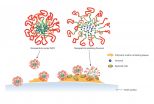Penn Medicine: New receptors could underlie the many actions of the anesthetic ketamine
First of its kind study uses olfactory receptor screening, high-tech computer models and simulations to identify and turn binding sites for increased and decreased ketamine response
2015-04-01
(Press-News.org) PHILADELPHIA-- Penn Medicine researchers are continuing their work in trying to understand the mechanisms through which anesthetics work to elicit the response that puts millions of Americans to sleep for surgeries each day. Their most recent study looked at ketamine, an anesthetic discovered in the 1960s and more recently prescribed as an anti-depressant at low doses. Through collaboration with the University of Pennsylvania's department of Chemistry and scientists at the Duke University Medical Center, researchers at Penn's Perelman School of Medicine have identified an entirely new class of receptors that ketamine binds in the body, which may underlie its diverse actions. The work is published in this week's issue of Science Signaling.
Ketamine is believed to act through glutamate receptors to produce anesthesia, but this is unlikely to explain the anti-depressant effect; most antidepressants target G-protein coupled receptors (GCPRs), the largest class of druggable receptors, located in the body's central nervous system (CNS). To explore the GCPR class of receptors, the investigators screened proteins present in the mouse nasal epithelium, olfactory receptors (ORs), which typically respond very selectively to compounds in the air, giving rise to smell. It turns out that these ORs are also present throughout the nervous system. ORs make up the largest group of GCPRs, yet they are unexplored as transducing components of general anesthesia or of antidepressants.
"Our hope is that we can visualize the precise molecular interactions between ketamine and ORs, and in turn, learn how this old drug interacts with these and other GCPRs throughout the central nervous system," says the study's senior author, Roderic Eckenhoff, MD, the Austin Lamont Professor of Anesthesiology and Critical Care at Penn.
Eckenhoff and a team at Duke University began their study by screening ORs of mice and found that ketamine activated only two types out of more than several hundred, known as MOR136 and MOR139. They then used computational modeling and simulation approaches with Jeffery Saven, PhD, professor of Chemistry at Penn to generate structural models of these ORs and to understand exactly how they recognize ketamine. Several amino acid residues were identified as critical determinants. The team found that by mutating these amino acids, they could turn ketamine responsiveness both on and off.
They also tested these conclusions in mice by stimulating the olfactory epithelium via intranasal application of ketamine and showed that olfactory sensory neurons that expressed these unique ORs responded to ketamine, suggesting that ORs may truly serve as functional targets for ketamine.
"Here we provide evidence that ketamine has a highly specific interaction with the ORs, indicating that at least some of ketamine's actions may result from these or other GCPRs in the central nervous system," says Eckenhoff, noting that "our rigorous combination of simulation and experiment indicates that we can design receptors to respond specifically to certain drugs, which gets us one step closer to doing the opposite and designing drugs to interact specifically with certain receptors."
INFORMATION:
Additional Penn authors include Jose Manuel Perez-Aguilar and Lu Gao, department of Chemistry.
This work was funded by NIH grants (DC010857, DC012095, and GM55876), the National Science Foundation through the Penn Nano/Bio Interface Center (NSEC DMR08-3202).
Penn Medicine is one of the world's leading academic medical centers, dedicated to the related missions of medical education, biomedical research, and excellence in patient care. Penn Medicine consists of the Raymond and Ruth Perelman School of Medicine at the University of Pennsylvania (founded in 1765 as the nation's first medical school) and the University of Pennsylvania Health System, which together form a $4.9 billion enterprise.
The Perelman School of Medicine has been ranked among the top five medical schools in the United States for the past 17 years, according to U.S. News & World Report's survey of research-oriented medical schools. The School is consistently among the nation's top recipients of funding from the National Institutes of Health, with $409 million awarded in the 2014 fiscal year.
The University of Pennsylvania Health System's patient care facilities include: The Hospital of the University of Pennsylvania -- recognized as one of the nation's top "Honor Roll" hospitals by U.S. News & World Report; Penn Presbyterian Medical Center; Chester County Hospital; Penn Wissahickon Hospice; and Pennsylvania Hospital -- the nation's first hospital, founded in 1751. Additional affiliated inpatient care facilities and services throughout the Philadelphia region include Chestnut Hill Hospital and Good Shepherd Penn Partners, a partnership between Good Shepherd Rehabilitation Network and Penn Medicine.
Penn Medicine is committed to improving lives and health through a variety of community-based programs and activities. In fiscal year 2014, Penn Medicine provided $771 million to benefit our community.
ELSE PRESS RELEASES FROM THIS DATE:
2015-04-01
ALEXANDRIA, VA -- An updated clinical practice guideline from the American Academy of Otolaryngology--Head and Neck Surgery Foundation published today in Otolaryngology-Head and Neck Surgery identifies quality improvement opportunities and explicit actionable recommendations for clinicians managing adult sinusitis, including a greater focus on patient education and patient preference.
"More than ever before, there is a prominent role for shared decision-making between patients and clinicians when managing adult sinusitis--especially in deciding whether to use antibiotics ...
2015-04-01
In 2006 construction began on a new shopping centre in Tulln. The works unearthed various archaeologically valuable objects that were salvaged during rescue excavations. Among these objects was also the complete skeleton of a large mammal.
Large mammal uncovered during excavations in Tulln
"The partly excavated skeleton was at first suspected to be a large horse or cattle," says archaeozoologist Alfred Galik from the Institute for Anatomy, Histology and Embryology at the University of Veterinary Medicine Vienna. "But one look at the cervical vertebrae, the lower jaw ...
2015-04-01
Therapeutic agents intended to reduce dental plaque and prevent tooth decay are often removed by saliva and the act of swallowing before they can take effect. But a team of researchers has developed a way to keep the drugs from being washed away.
Dental plaque is made up of bacteria enmeshed in a sticky matrix of polymers--a polymeric matrix--that is firmly attached to teeth. The researchers, led by Danielle Benoit at the University of Rochester and Hyun Koo at the University of Pennsylvania's School of Dental Medicine, found a new way to deliver an antibacterial agent ...
2015-04-01
People who apply eyeliner on the inner eyelid run the risk of contaminating the eye and causing vision trouble, according to research by a scientist at the University of Waterloo. This is the first study to prove that particles from pencil eyeliner move into the eye.
Dr. Alison Ng, at the Centre for Contact Lens Research at Waterloo, directed the study when she was at Cardiff University in Wales. The team's findings appear in Eye and Contact Lens Science and Clinical Practice, the official peer-reviewed journal of the Contact Lens Association of Ophthalmologists.
Dr. ...
2015-04-01
If you are trying to have a baby, a good night's sleep is more important than ever. A new research report appearing in The FASEB Journal shows that the womb has its own "body clock" that needs to synchronize with the mother's body clock to ensure optimal conditions for fetal growth and development. The inability of a mother's body clock to synchronize with the womb's clock may be at least part of the reason why some women have difficulty carrying a pregnancy to full term. Specifically, the failed synchronization switches off body clock genes in cells lining the womb, which ...
2015-04-01
ANCHORAGE, Alaska -- A team of scientists led by the U.S. Geological Survey found that polar bears, increasingly forced on shore due to sea ice loss, may be eating terrestrial foods including berries, birds and eggs, but any nutritional gains are limited to a few individuals and likely cannot compensate for lost opportunities to consume their traditional, lipid-rich prey -- ice seals.
"Although some polar bears may eat terrestrial foods, there is no evidence the behavior is widespread," said Dr. Karyn Rode, lead author of the study and scientist with the USGS. "In the ...
2015-04-01
Washington, DC--Night owls are more likely to develop diabetes, metabolic syndrome and sarcopenia than early risers, even when they get the same amount of sleep, according to a new study published in the Endocrine Society's Journal of Clinical Endocrinology & Metabolism.
The study examined the difference between night and morning chronotypes, or a person's natural sleep-wake cycle. Staying awake later at night is likely to cause sleep loss, poor sleep quality, and eating at inappropriate times, which might eventually lead to metabolic change.
"Regardless of lifestyle, ...
2015-04-01
Washington, DC--Exposure to the endocrine-disrupting chemical bisphenol A during pregnancy may raise a mother's susceptibility to weight gain and diabetes later in life, according to a new animal study published in the Endocrine Society's journal Endocrinology.
A chemical used to manufacture plastics and epoxy resins, bisphenol A (BPA) is found in a variety of consumer products, including plastic bottles, food cans and cash register receipts. The U.S. Centers for Disease Control and Prevention have estimated that more than 96 percent of Americans have BPA in their bodies.
BPA ...
2015-04-01
Cambridge, Mass. April 1, 2015-- A collaborative study between researchers from the Broad Institute of MIT and Harvard, Massachusetts Institute of Technology, and the National Center for Biotechnology Information of the National Institutes of Health (NIH-NCBI) has identified a highly efficient Cas9 nuclease that overcomes one of the primary challenges to in vivo genome editing. This finding, published today in Nature, is expected to help make the CRISPR toolbox accessible for in vivo experimental and therapeutic applications.
Originally discovered in bacteria, the CRISPR-Cas9 ...
2015-04-01
Many microbes cannot be cultivated in a laboratory setting, hindering attempts to understand Earth's microbial diversity. Since microbes are heavily involved in, and critically important to environmental processes from nutrient recycling, to carbon processing, to the fertility of topsoils, to the health and growth of plants and forests, accurately characterizing them, as a basis for understanding their activities, is a major goal of the Department of Energy (DOE). One approach has been to study collected DNA extracted from the complex microbial community, or the metagenome, ...
LAST 30 PRESS RELEASES:
[Press-News.org] Penn Medicine: New receptors could underlie the many actions of the anesthetic ketamine
First of its kind study uses olfactory receptor screening, high-tech computer models and simulations to identify and turn binding sites for increased and decreased ketamine response


